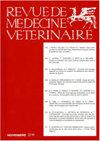Frecuencia y susceptibilidad antimicrobiana del estafilococo coagulasa negativo aislado de mastitis bovina en fincas lecheras del Tolima, Colombia
Q2 Veterinary
引用次数: 6
Abstract
Objective : To determine the antimicrobial presence and susceptibility of the coagulase-negative staphylococci group (ECN, for its initials in Spanish) in some cattle farms from Tolima, Colombia. Materials and methods : Using the California test for the diagnosis of mastitis (CMT, for its initials in Spanish), 484 quarters belonging to 121 cows from five small production ranches from a region of central Tolima were evaluated. CMT positive samples were cultivated for bacterial isolation. The ECN found were tested for susceptibility to the antibiotics. The results were analyzed with descriptive statistics. Results: 252 (52%) quarters did not show any type of reaction to the CMT, nor did they show any clinical signs of mastitis, therefore they were considered free of the disease. From the quarters, 73 (15%) turned positive for CMT and bacteriological culture. From these, 36 strains of ECN were isolated (7.4% of the total of quarters); S. aureus -ECP, 28 (5.8%); Streptococcus spp., 6 (1.2%).; Escherichia coli , 2 (0.4%), and Klebsiella pneumoniae , 2 (0.2%). The clinical and subclinical mastitis in the quarter occurred in 1.4% and 13.6%, respectively. In 5 (1.0%) of the quarters, clinical mastitis caused by ECN was found and subclinical mastitis in 31 (6.4%). 61% of the ECN strains were resistant to penicillin, and 58%, to tetracycline; 97% were sensitive to cefoperazone. Conclusion : The ECN group, considered a global emergent of mastitis, is evidenced with high frequency in ranches from Tolima, Colombia, causing clinical and subclinical mastitis with varied response to antimicrobials.哥伦比亚托利马奶牛场牛乳腺炎分离凝固酶阴性葡萄球菌的频率和抗菌敏感性
目的:测定哥伦比亚托利马一些牛场中凝固酶阴性葡萄球菌群(ECN,为西班牙语首字母缩写)的抗微生物活性和药敏性。材料和方法:使用加利福尼亚乳腺炎诊断测试(CMT,西班牙语缩写),对托利马中部地区5个小型生产牧场的121头奶牛的484个季度进行了评估。培养CMT阳性样品进行细菌分离。对发现的ECN进行了抗生素敏感性测试。结果用描述性统计进行分析。结果:252例(52%)患者对CMT未表现出任何类型的反应,也未表现出任何乳腺炎的临床症状,因此认为他们没有疾病。从季度来看,73例(15%)CMT和细菌培养呈阳性。从中分离出ECN 36株(占季度总数的7.4%);金黄色葡萄球菌-ECP, 28例(5.8%);链球菌,6 (1.2%);大肠杆菌2例(0.4%),肺炎克雷伯菌2例(0.2%)。本季度临床乳腺炎和亚临床乳腺炎发生率分别为1.4%和13.6%。5个季度(1.0%)发现ECN引起的临床乳腺炎,31个季度(6.4%)发现亚临床乳腺炎。61%的ECN菌株对青霉素耐药,58%对四环素耐药;97%的患者对头孢哌酮敏感。结论:ECN组被认为是一种全球性的乳腺炎,在哥伦比亚Tolima的牧场中发病率很高,引起临床和亚临床乳腺炎,对抗菌素的反应各不相同。
本文章由计算机程序翻译,如有差异,请以英文原文为准。
求助全文
约1分钟内获得全文
求助全文
来源期刊

Revue De Medecine Veterinaire
农林科学-兽医学
CiteScore
1.30
自引率
0.00%
发文量
0
审稿时长
18-36 weeks
期刊介绍:
The Revue de Médecine Vétérinaire publishes four kinds of text:
1) Scientific reviews on subjects related to veterinary and comparative medicine. Suggested length: 10 to 30 typed pages.
2) Original reports on fundamental or applied research. Suggested length: 10 to 15 typed pages.
3) Continuous education articles, that should be easily understandable by non-specialists. Suggested length: 10 to 15 typed pages.
4) Clinical reports. Suggested length: 5 to 15 typed pages.
The publication can be done in French language or English language.
For an article written in English by not english native speakers authors, the manuscript must be subjected by attesting that it was read again by an anglophone scientist or a scientific translator.
The authors must certify that the manuscript was not published or subjected for publication to another review.
The manuscript must be accompanied by a sheet signed by all the joint authors indicating their agreement for the tender of the manuscript.
The publication is free but a financial participation could be required for the photographs color. An estimate will be sent to collect the agreement of the authors.
 求助内容:
求助内容: 应助结果提醒方式:
应助结果提醒方式:


